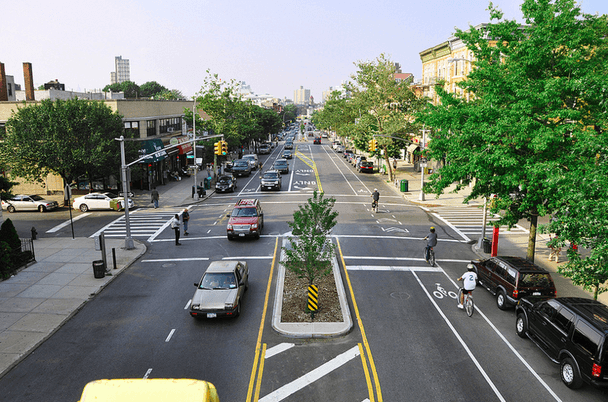Walk, Bike and Ride on Complete Streets Day
by Amy Bell, PLA, ASLA
FBT Architects Landscape Architect
Amy is Past President of the New Mexico Chapter of the American Society of Landscape Architects (NMASLA) and is leading the planning effort for Complete Streets Advocacy Day on Feb 11.

Photo credit: New York City Department of Transportation
The New Mexico American Society of Landscape Architecture (NMASLA) is heading to the Roundhouse to meet with Legislators to advocate for Complete Streets policy February 11. For more information or to register for the event, nmasla.org. The mission of the Complete Streets Leadership Team is to improve health and safety of New Mexicans by increasing active transportation via policies and practices by state, local and tribal governments.
What makes a street “complete”?
- Safety, accessibility, connectivity and comfort for all ages and abilities, from motorists and bicyclists to pedestrians and bus riders.
Why does New Mexico need Complete Streets?
- Complete Streets save lives.
From 2000-2009, New Mexico had 548 pedestrian fatalities, which ranked them 2nd in the nation for pedestrian fatalities per capita (4th for bicyclist fatalities). Since 2009, the statistics have improved. The 2014 stats and pedestrian fatalities for any neighborhood in the Dangerous by Design 2014 Report are available here. The recent Lead/Coal Avenue improvements in Albuquerque are highlighted in this report as an example of successful Complete Streets.
- Complete Streets are good for business.
Making our streets safer increases foot and bicycle traffic for local businesses. A recent study, Walking the Walk: How Walkability Raises Home Values in U.S. Cities, showed that houses with above average levels of walkability sold for as much as $34,000 over houses with average levels. From a design and construction standpoint, Complete Streets also help small and local businesses. Unlike engineering-focused roadway projects, complete streets require an interdisciplinary design approach and more varied skills that are typically provided by smaller, local, specialized firms.
- Complete Streets promote good health.
According to the CDC’s Guide to Community Preventive Services, Complete Streets components such as sidewalks, safer street crossings, multi-use pathways, and bike lands increase rates of physical activity by a median rate of 35%. Walking and bicycling are proven ways to address obesity (a national epidemic) and other chronic health problems like diabetes, heart disease, and asthma. Increased use of alternative forms of transportation reduces vehicular carbon emissions, which improves air quality.
- Complete Streets are better for cars.
On a Complete Street, different modes of transportation are appropriately separated and different travel routes (i.e. a bike lane or sidewalk) are clearly marked. Mid-block crossings are provided, so motorists don’t have to dodge jaywalkers racing across the street to catch their bus. Additionally, if more people are walking, biking, or taking public transit, there will be less traffic.
What’s New Mexico doing to implement Complete Streets?
New Mexico has yet to implement any statewide policy addressing Complete Streets. The NM DOT is currently working on their Long Range Transportation Plan, which is likely to include some Complete Streets components. On Wednesday, Jan. 21st, the Albuquerque City Council passed the Complete Streets Ordinance (O-14-27), introduced last year by Councilor Benton. The passing of this ordinance will have a hugely beneficial impact on the safety and functionality of Albuquerque’s streets, while providing a valuable example for other municipalities in New Mexico. Learn more about the ordinance here.
While all of these efforts are commendable, New Mexico shouldn’t be left behind as the rest of the nation generates jobs and improves community and environmental health with Complete Streets efforts. On the Federal level, Complete Streets legislation (the “Safe Streets Act,” HR 2468 & S2004) was introduced in both chambers of Congress last year. The bill had impressive bipartisan support, and is likely to be reintroduced in March of this year. Over 600 state and local Complete Streets policies have been adopted throughout the nation. See who’s on the list here.
New Mexico state policy would encourage and support local policy, making it easier for local municipalities to receive state funding for Complete Streets improvements. Join NMASLA in our Advocacy effort on Wednesday, February 11 at the Santa Fe Roundhouse, and help contribute to the movement to make New Mexico’s streets safer and more accessible for everyone. Register for the event at NMASLA.ORG.

